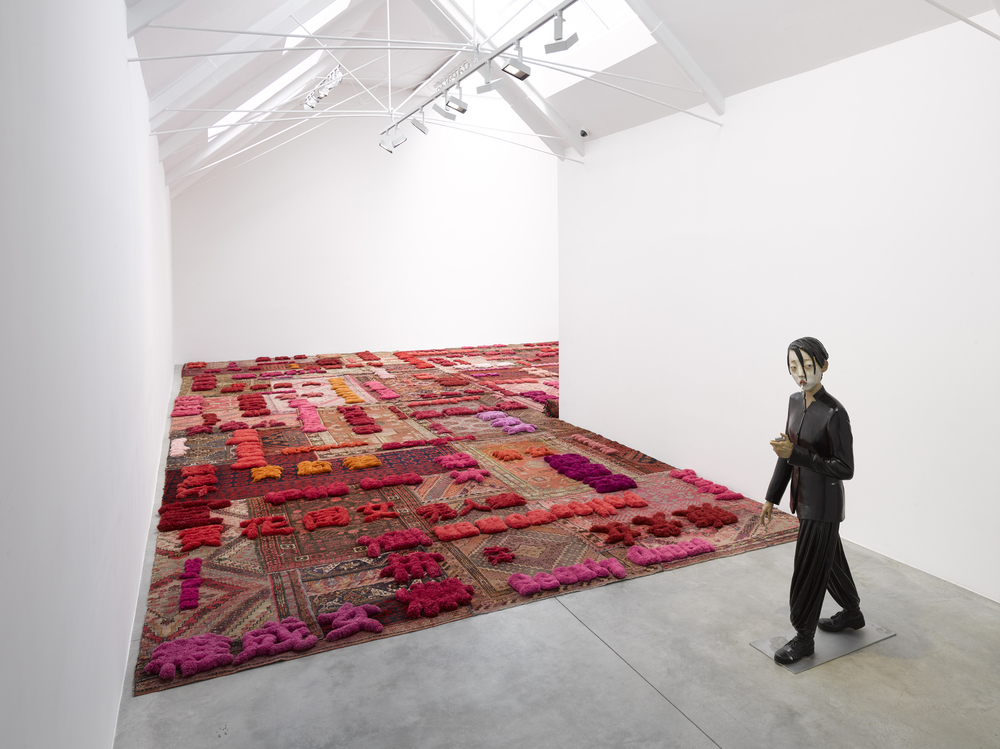 Installation view ‘Afterimage: Dangdai Yishu‘ at Lisson Gallery, London, 2019, © the artists; courtesy Lisson Gallery
Installation view ‘Afterimage: Dangdai Yishu‘ at Lisson Gallery, London, 2019, © the artists; courtesy Lisson Gallery
Afterimage: Dangdai Yishu
aaajiao | Lin Tianmiao | Ma Qiusha | Wang Youshen | Xiang Jing | Shen Xin | Yu Hong | Zhao Zhao | Li Binyuan
Curated by Victor Wang
LISSON GALLERY
67 Lisson Street & 27 Bell Street
London
3 July – 7 September 2019
Lisson Gallery’s summer exhibitions continue the gallery’s long-running commitment to presenting new art and new approaches to art as defined by guest curators. This year, curator Victor Wang offers a fresh interpretation and alternate trajectory for the development and genealogy of dangdai yishu (the Chinese phrase for ‘contemporary art’) as an open and discursive term, rather than a temporal or geographical definition. Taking a critical distance from established movements and narratives, ‘Afterimage: Dangdai Yishu’ brings together work by several generations of artists born between 1960 and 1990. It includes many artists not shown previously in the UK including seminal figures Wang Youshen,Yu Hong, Lin Tianmao and Xiang Jing, as well as a new generation of practitioners Shen Xin, aaajiao, Ma Qiusha and Zhao Zhao.
Employing a framework of critical research rather than prior validation and repositioning both Chinese and Euro-American assumptions, ‘Afterimage: Dangdai Yishu’ attempts an overdue appreciation of the impact and lineage of what Wang calls the ‘post-figurative condition’ or hou juxiang zhuangtai, set in motion by China’s ’85 New Wave movement, and now reflected in the current artistic scene in China. Although denied a prolonged dialogue with 20th century Modernism, the threads and development of video (yingxiang yishu), installation (zhuangzhi yishu) and performance art (xingwei yishu) in Chinese contemporary art are more entangled and rich than would be suggested were they mere by-products of Western art-historical concepts or of the artistic and political upheaval following the Cultural Revolution.
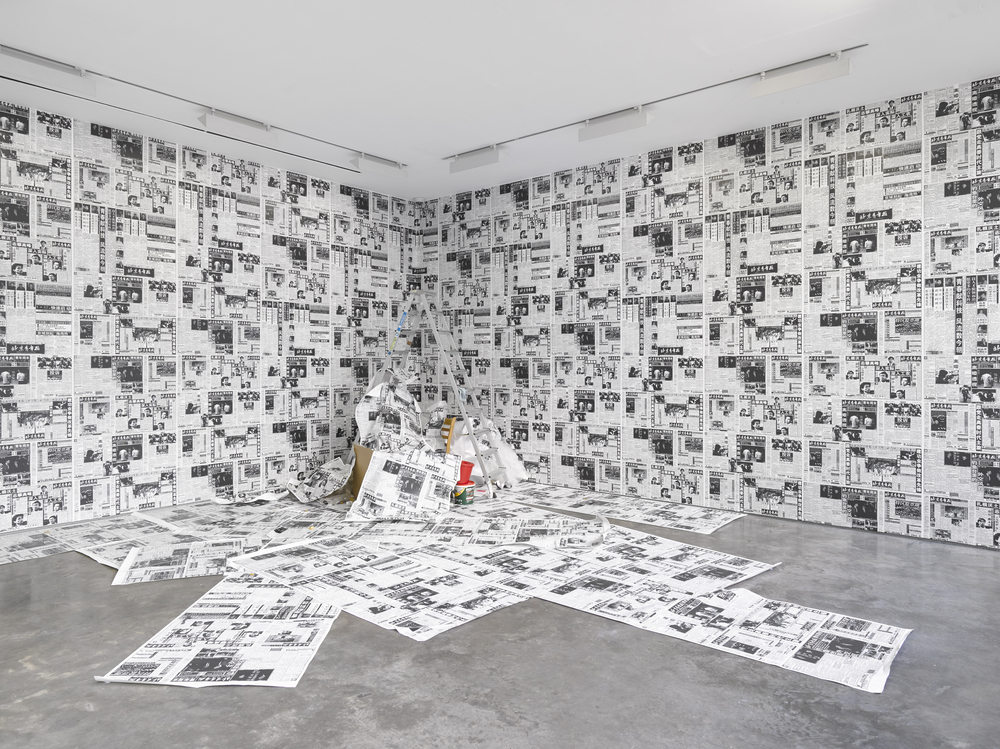
Wang Youshen, ‘Newspaper / Interior decoration’, 1993-2019, installation view, ‘Afterimage: Dangdai Yishu‘, Lisson Gallery, © the artists; courtesy Lisson Gallery
Many important local concepts and artists emerged from an era of experimentation during the 1980s, including Yu Hong, a painter who began her annual ritualised acts of self-portraiture, entitled Witness to Growth, in 1999 (pictured above is a detail of Twenty-six years old: A photo showing a scene in the film “The Days” 1992, 2001), in which she depicts herself or a personal event, in tandem with a contemporaneous newspaper story or magazine article from the same year. Wang Youshen was also active in the early 1990s, making similarly timely political statements including an audacious pasting of newspaper pages across an entire section of China’s Great Wall – an act of cultural commentary, or perhaps restoration, which he will be recreating across various walls of the Lisson Gallery.
A younger generation born after those tumultuous years and working within a global context will also be represented in the show, from aaajiao, whose DIY wall-coverings are infested with 404 messages from blocked websites from the continuing era of internet censorship within the so-called ‘great firewalls’ of .cn, to the nuanced video portraits depicting the diversity of ethic groups found in the contested region of Xinjiang, an inspection of nationhood and alienation by Zhao Zhao.

Installation view, works by Yu Hong, ‘Afterimage: Dangdai Yishu‘, Lisson Gallery, London, 2019, © the artists; courtesy Lisson Gallery
Instead of simply defining Chinese art by geography or dividing it into pre-modern and post-modern, Wang proposes a lineage in which decades of figurative art and teaching have resulted in the conditions necessary for the current period of post-figuration, through interdisciplinary practices with pluralistic outputs. In relation to Chicago-based Professor Wu Hung’s theories of a globalised and ‘deterritorialised’ Chinese art landscape – partly expounded in his book Making History of 2008 – Wang posits a ‘transcategorical’ tendency linking the profusion of media, identities and nationalities within his grouping of dangdai yishu, as he explains in his curatorial statement:
"The exhibition 'Afterimage: Dangdai Yishu' is divided into three interrelated chapters, in order to examine a moment in Chinese contemporary art that signifies both a break with the tradition of aesthetic artistic value based on technical skills that has been advocated by Chinese art academies from the twentieth century onwards and the gradual shift into new subjectivities that resist traditional concepts relating to artistic medium, authorship and meaning, which can be understood as hou juxiang zhuangtai 后具象状态, or the ‘post-figurative condition’, in contemporary Chinese art.
Following the radical transformations set in motion by China’s ’85 New Wave movement in the 1980s, and the subsequent post-reform policies, the early 1990s and the early 2000s saw several radical developments in the visual arts. Among them was the broad exploration of artistic techniques that readdressed or countered the standardized forms of art education in the region, centred on teaching technical skills from the academies. There was also an acceptance of the concept that all materials, not just the traditional ones used in painting, calligraphy, writing and sculpture, could be used to make a work of art, as well as an increased access to video-making technologies and the rise of artistic movements, temporary exhibitions and socially based and ‘idea’-based art forms that embodied questions of identity, class, gender and larger socio-political relations.
Rather than a shift towards abstraction, the post-figurative condition signified a questioning of the parameters which had previously been established and the emergence of a new, undefined 'transcategorial' space in which new media and networks such as yingxiang yishu 影像藝術 (video art), zhuangzhi yishu 装置艺术 (installation art) and xingwei yishu 行为艺术 (performance art) would arise. Rather than considering these to be derivative of Western art-historical concepts, the exhibition asks whether these existing concepts, or what professor and author Wu Hung describes as ‘loan words’ from the study of Euro-American art, which are not based on “on first-hand research of Chinese art-historical reality”(1), are still serviceable in understanding the multifaceted condition and history of contemporary Chinese art, and how to continue thinking critically beyond such genealogies.
The exhibition follows these developments into the present by framing three interrelated chapters: first, to show that a new generation of contemporary artists (born after the Cultural Revolution) can no longer be defined by geographical region or country of origin, and that new transnational identities and diasporas need to be considered against the rapid expansion of a global art network. Second, that ‘dangdai yishu’, as a Chinese contemporaneity, is both an incomplete and a dynamic extension that is only recently being understood by moving across the disciplinary formations of media, exhibition histories, artworks, institutions and waves of emigration and reworking the historical relations between them in order to formulate a critical concept that moves beyond the notion of international presentness. For the emergence of the modern period of Chinese art history did not naturally grow out of a pre-modern tradition, but rather as part of a sweeping global modernisation movement in the 19th and 20th centuries – which inscribes its ‘out-of-placeness’.
This exhibition attempts to formulate a critical referent around dangdai yishu both from below and in reverse. The hou juxiang zhuangtai 后具象状态 (post-figurative condition) can therefore be understood as a specific accelerated zhuangtai 状态 (state) that arose from the attempted reconstruction by artists in the region of a tangential replacement, through the applied understanding of art. The cataclysmic rupture of the juxiang 具象 (figurative image) occurred first through the fracturing of the concept of a self or identity both culturally and socially by rapid reform and opening-up policies, then through the injection of modernizing forces and institutions to the continued importing, translating, and censoring of foreign literature and art. Combined with significant socio-political events in the region this created the entanglement between the self-designating periodizing term contemporary art, that emerged in Euro-America after 1945, and the parallel development of the term dangdai yishu which did not emerge in China as a label until the early 1990s."
1. Wu Hung (2019), ‘The Sixty-Eighth A. W. Mellon Lectures in the Fine Arts: End as Beginning: Chinese Art and Dynastic Time, Part 1: The Emergence of Dynastic Time in Chinese Art’ (lecture), National Gallery of Art, Washington, 31 March 2019, available at: https://www.nga.gov/audio-video/mellon/mellon-2019-1.html
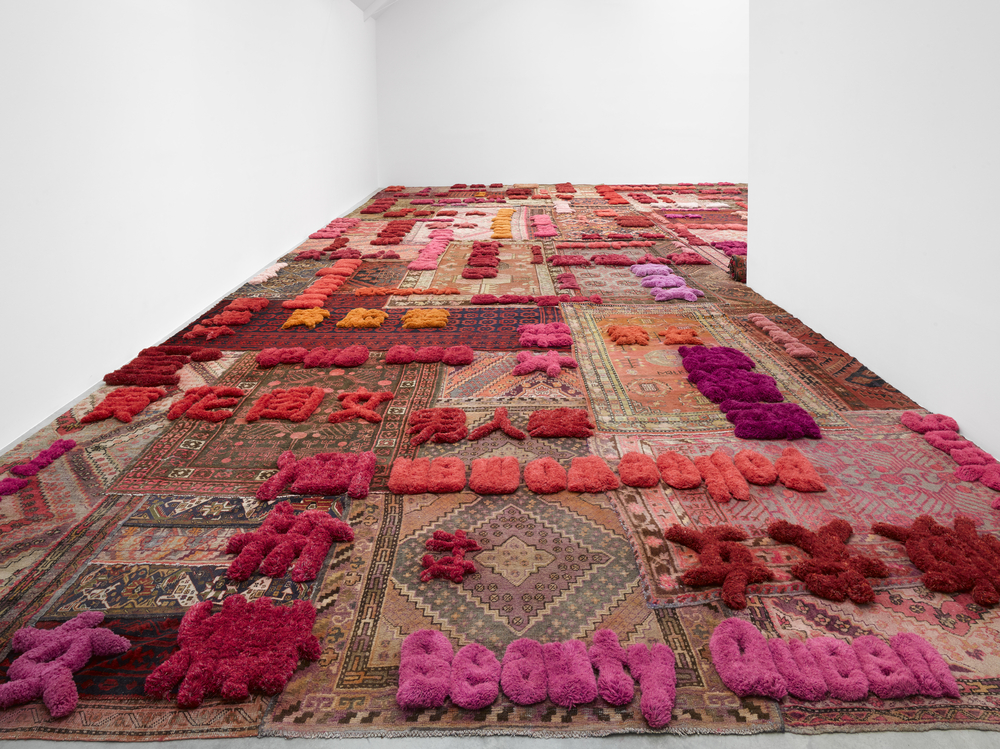
Lin Tianmiao, ‘Protruding Patterns’,2014, installation view, ‘Afterimage: Dangdai Yishu‘, Lisson Gallery,© the artists; courtesy Lisson Gallery
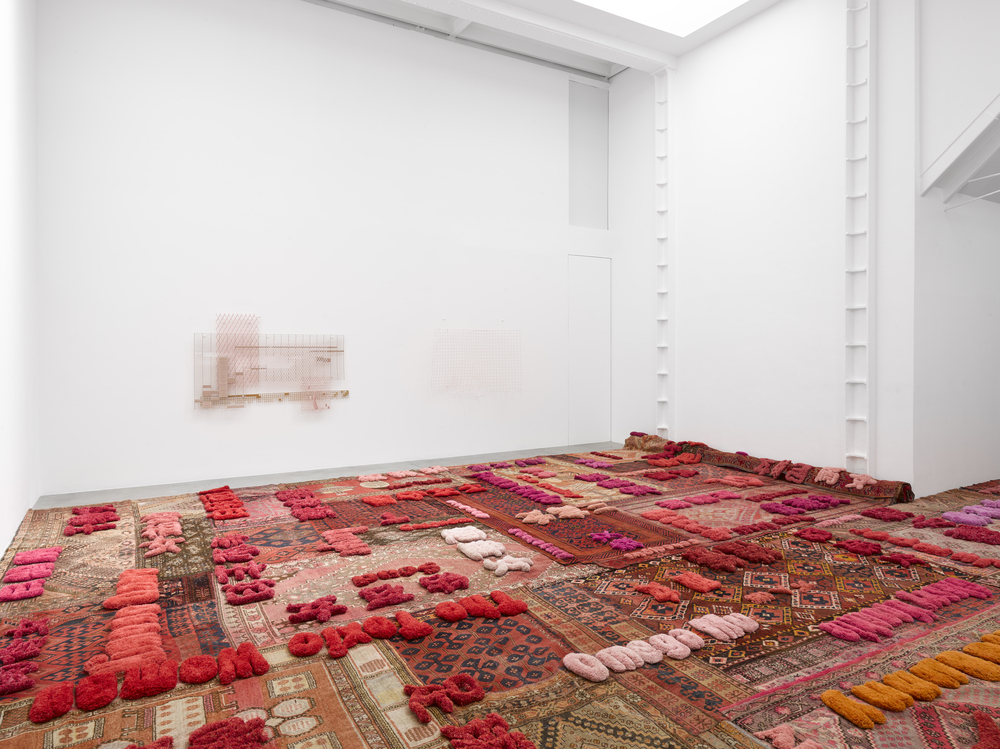
Installation view ‘Afterimage: Dangdai Yishu‘ at Lisson Gallery, London, 2019, © the artists; courtesy Lisson Gallery
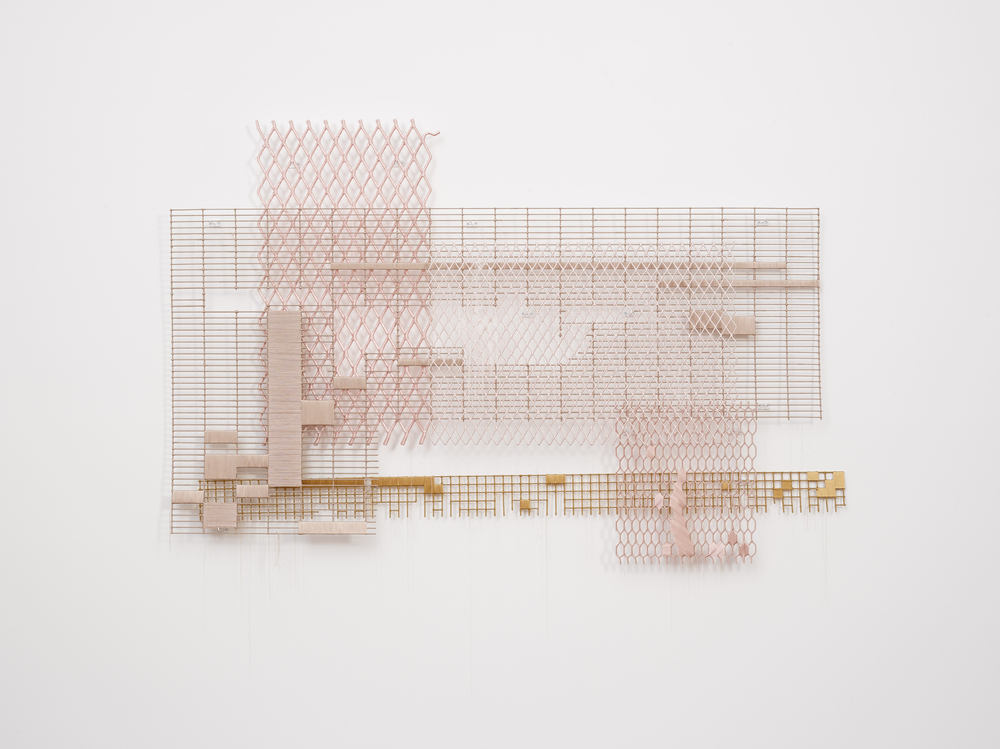
Lin Tianmiao, ‘Interconnectedness #2’, 2019, installation view © the artists; courtesy Lisson Gallery

Lin Tianmiao, ‘Interconnectedness #2’(detail), 2019,installation view © the artists; courtesy Lisson Gallery
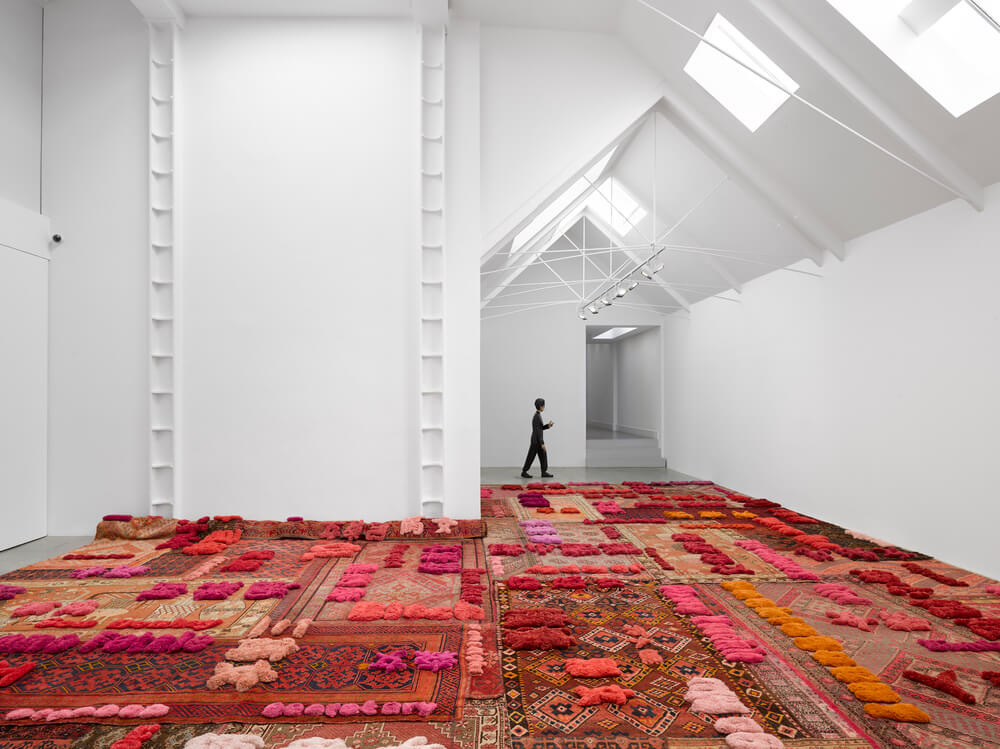
Installation view ‘Afterimage: Dangdai Yishu‘ at Lisson Gallery, London, 2019, © the artists; courtesy Lisson Gallery
 Xiang Jing, ‘Whole Dark‘, 2005, ‘Afterimage: Dangdai Yishu‘, Lisson Gallery, © the artists; courtesy Lisson Gallery
Xiang Jing, ‘Whole Dark‘, 2005, ‘Afterimage: Dangdai Yishu‘, Lisson Gallery, © the artists; courtesy Lisson Gallery
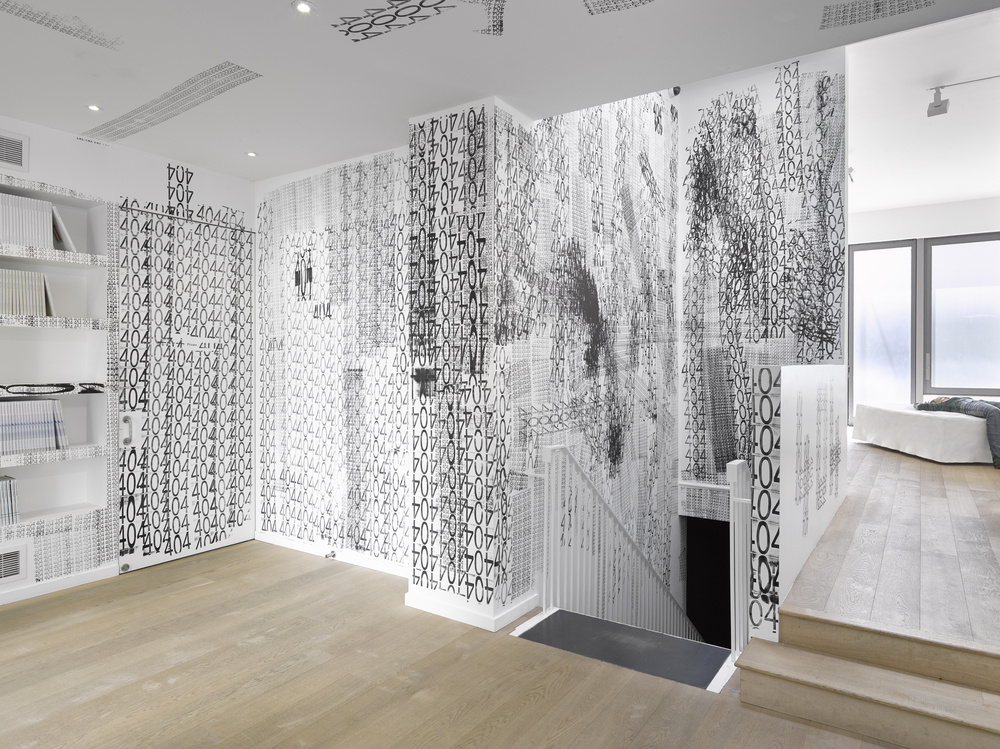 aaajiao, ‘404’, 2017, installation view, ‘Afterimage: Dangdai Yishu‘, Lisson Gallery, © the artists; courtesy Lisson Gallery
aaajiao, ‘404’, 2017, installation view, ‘Afterimage: Dangdai Yishu‘, Lisson Gallery, © the artists; courtesy Lisson Gallery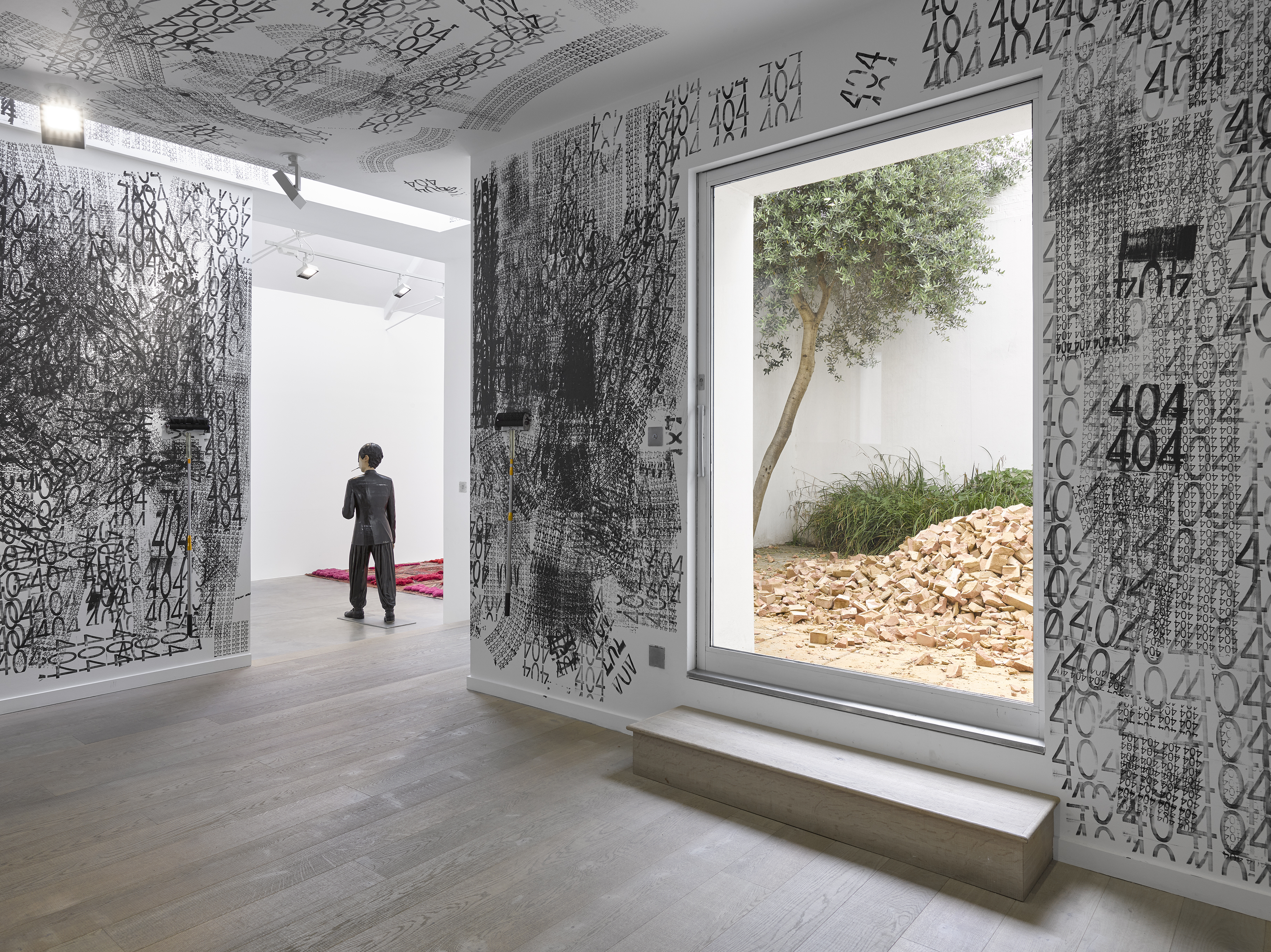
Installation view ‘Afterimage: Dangdai Yishu‘ at Lisson Gallery, London, 2019, © the artists; courtesy Lisson Gallery
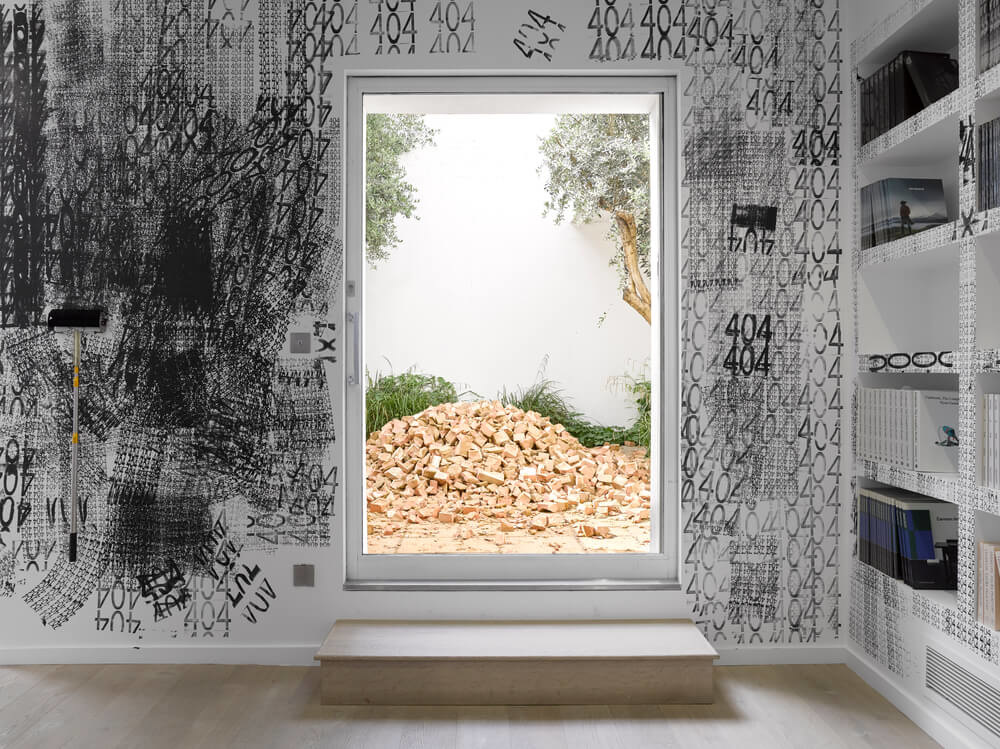
aaajiao, ‘404’, 2017, installation view © the artists; courtesy Lisson Gallery
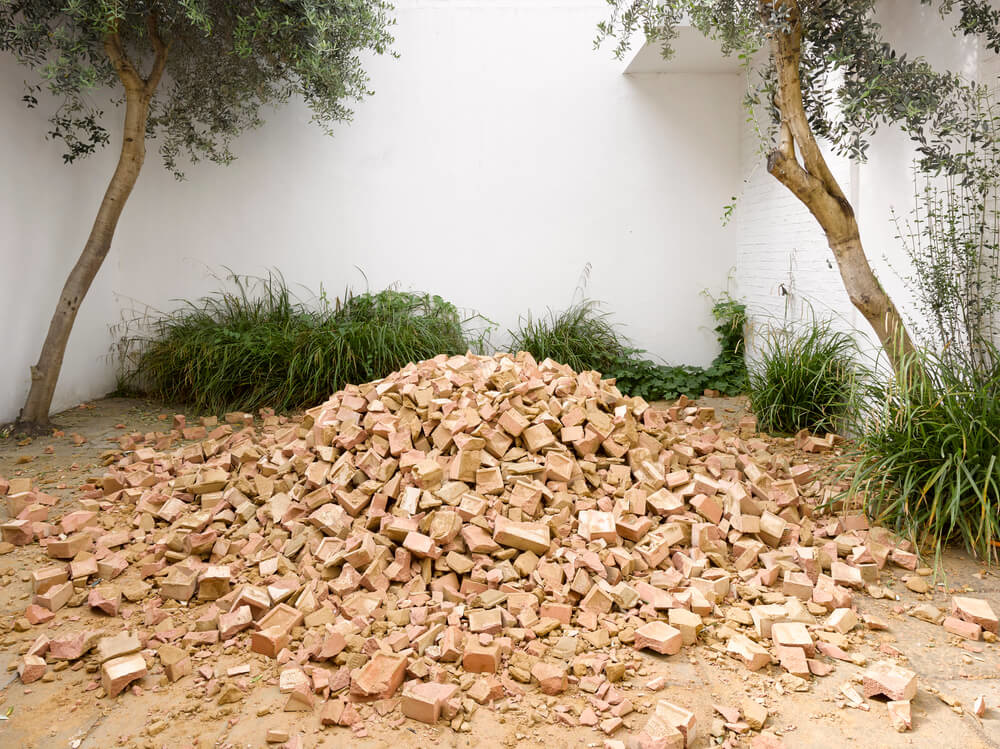
Li Binyuan ‘Breakdown’ (2019), ‘Afterimage: Dangdai Yishu‘, Lisson Gallery, © the artists; courtesy Lisson Gallery
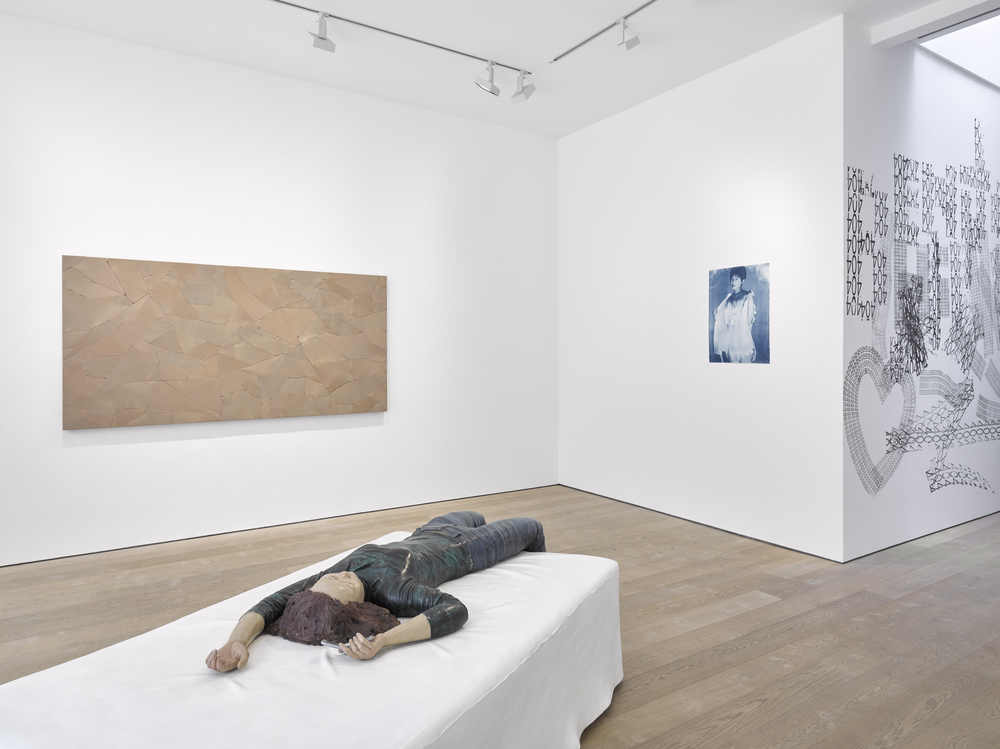
Installation view ‘Afterimage: Dangdai Yishu‘ at Lisson Gallery, London, 2019, © the artists; courtesy Lisson Gallery
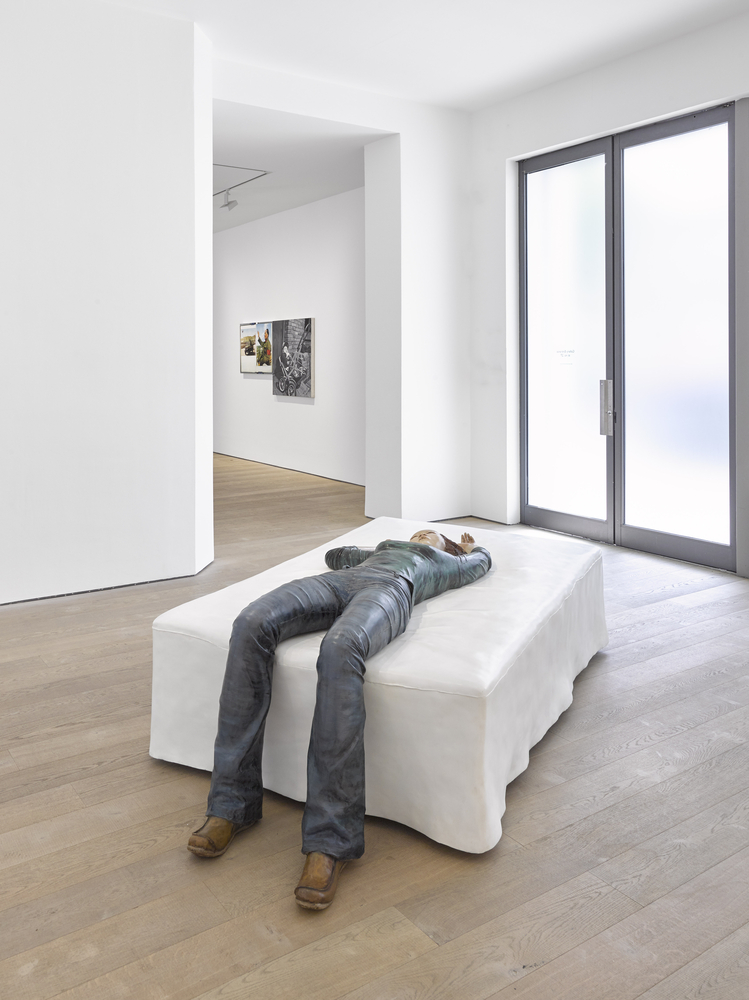
Xiang Jing, ‘Slipping, Ticktock Ticktock’ (2005) Installation view ‘Afterimage: Dangdai Yishu‘ at Lisson Gallery, London, 2019, © the artists; courtesy Lisson Gallery
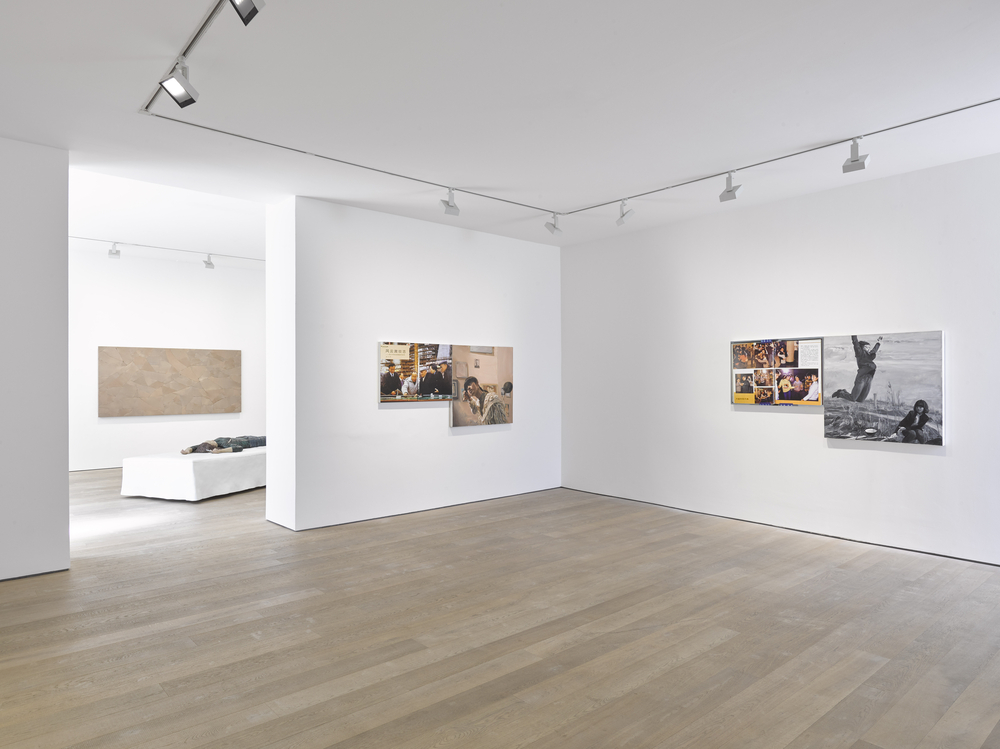
Installation view ‘Afterimage: Dangdai Yishu‘ at Lisson Gallery, London, 2019, © the artists; courtesy Lisson Gallery

Installation view Yu Hong, at Lisson Gallery, London, 2019, © the artists; courtesy Lisson Gallery
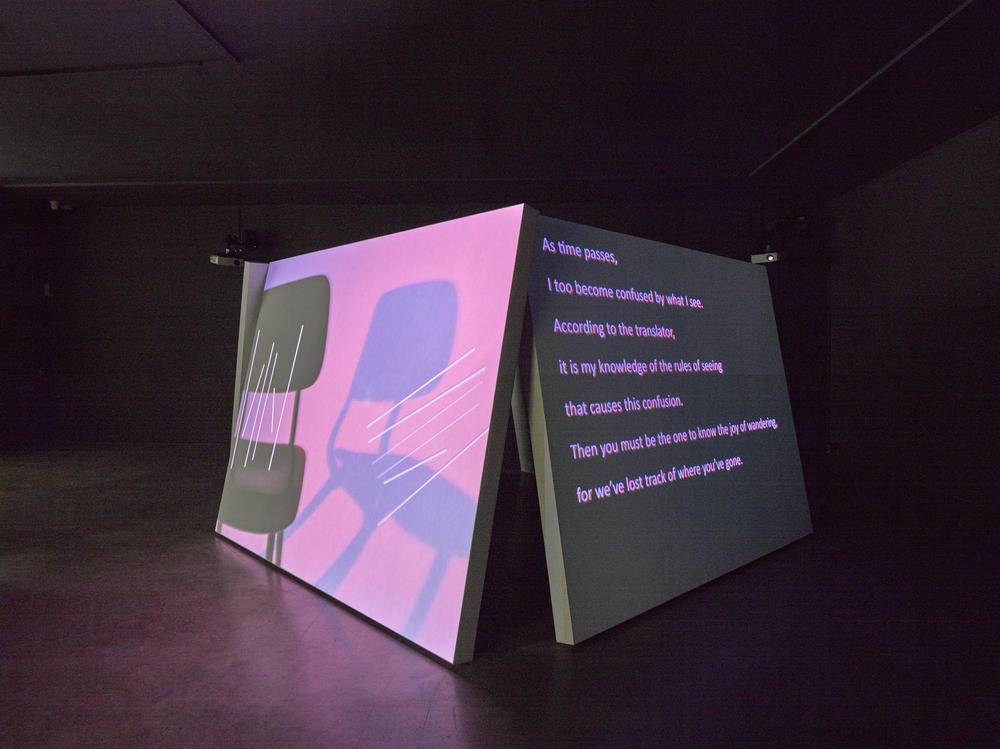 Shen Xin, ‘Commerce des Esprits’, 2018, Four-channel video installatio, installation view, ‘Afterimage: Dangdai Yishu‘, Lisson Gallery, © the artists; courtesy Lisson Gallery
Shen Xin, ‘Commerce des Esprits’, 2018, Four-channel video installatio, installation view, ‘Afterimage: Dangdai Yishu‘, Lisson Gallery, © the artists; courtesy Lisson Gallery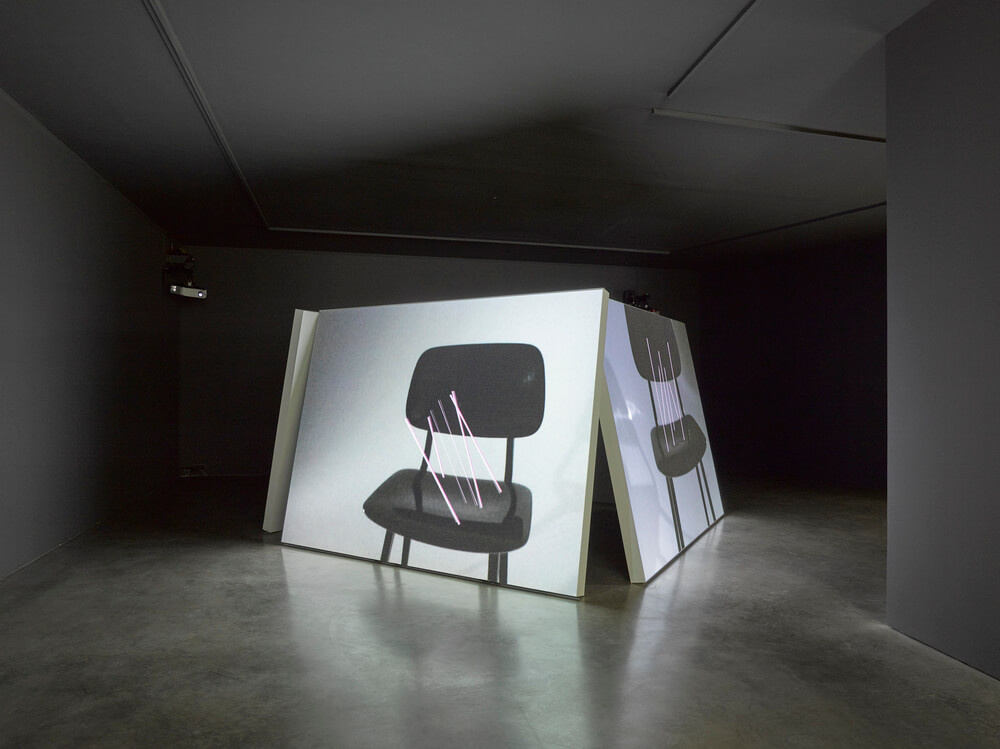
Shen Xin, ‘Commerce des Esprits’, 2018, Four-channel video installatio, installation view, ‘Afterimage: Dangdai Yishu‘, Lisson Gallery, © the artists; courtesy Lisson Gallery

Wang Youshen, ‘Newspaper / Interior decoration’, 1993-2019, installation view, ‘Afterimage: Dangdai Yishu‘, Lisson Gallery, © the artists; courtesy Lisson Gallery

Wang Youshen, ‘Newspaper / Interior decoration’, 1993-2019, installation view © the artists; courtesy Lisson Gallery

Wang Youshen, ‘Newspaper/advertising’, 1993 and ‘Newspaper / Interior decoration’, 1993-2019, installation view © the artists; courtesy Lisson Gallery
Chinese Press Release
新闻稿
余像:当代艺术
厉槟源 | 林天苗 | 马秋莎 | 王友身 | 向京 | 徐文恺 | 沈莘 | 喻红 | 赵赵
策展人:王宗孚
2019年7月3日至9月7日
里森街67号&贝尔街27号,里森画廊伦敦空间
开幕时间:7月2日(周二)下午6-8点
里森画廊夏季展秉承画廊一贯传统,由特邀策展人策划并呈现新的艺术和新的创作手法。今年,策展人王宗孚对中国“当代艺术”的发展系谱进行新的解读,试图将其作为更具开放性和探讨性的概念,抛却了历史上对“当代艺术”来自单一时间点或地点的定义而在新的轨迹加以诠释。《余像:当代艺术》特意与已经载入艺术史的各种运动和叙事保持批判距离,呈现了出生于上世纪60年代至90年代多位艺术家的作品。他们之中既有如王友身、喻红、林天苗、向京等首次在英国参展的中国当代艺术领军人物,也有沈莘、徐文恺、马秋莎、赵赵等新一代中国当代艺术家。
展览以批判研究为框架,摒除了在中国或欧美艺术语境中已存在的设想和定位,试图对王宗孚称之为“后具象状态”的影响和发展轨迹给予迟来的认可。“后具象状态”发源自85新潮,其影响在当前的中国艺术界十分深远。虽然未能与20世纪现代主义开展持续对话,但这也未尝不是幸事。如果仅仅被视为来自西方的艺术史概念,或文革后艺术政治大变革的副产品,影像艺术、装置艺术、行为艺术在中国当代艺术领域的发展线索或将远不及如今丰富而壮大。
充满实验精神的80年代涌现了许多重要的本土艺术概念和艺术家。喻红便是其中的代表人物。从1999年起,她每年为自己画一幅自画像,(题图为《1992 26岁 故事片《冬春的日子》剧照》,2001)将自己或者某个个人事件与同年出现的当代新闻或杂志文章并列呈现。她将这一系列命名为《目击成长》。王友身在90年代初也十分活跃,积极地在作品中发表政治宣言——用报纸覆盖了部分长城是他的一次标志性创举,这既是一种文化评论,或者也可以说是一种修复。此番,他将在里森画廊展厅的数面墙面上重现这件作品。
本次展览也呈现了年轻一代艺术家的创作,从未经历动荡岁月的他们一出道便在全球化的语境下开展创作。徐文恺的自制墙贴上布满404提示,醒目地揭示在“伟大的防火墙”对互联网的持续审查下被屏蔽封锁的网站。赵赵则带来了一件视频作品,细腻地表现出新疆地区民族的多元性,表达了艺术家对民族性和异化的观察和思考。
策展人并未简单地按区域或“前现代”、“后现代”等概念来定义中国艺术,而是提出一幅世系图。在这份世系图中,数十年的具象艺术创作和教学通过多元化输出的跨学科实践为当前的后具象时期提供了先决条件。巫鸿教授在其著作《制造历史》(2008)中提出全球化和“去疆界化”的中国艺术景观,在此基础上,策展人王宗孚在他的当代艺术群像中提出了一种“跨范畴”趋势,把媒介、身份和民族的丰富性联系在一起。正如他在策展人语中所写道的:
“群展《余像:当代艺术》由数个互相关联的篇章构成,聚焦中国当代艺术发展中的转折时刻,绘制 出一卷炫丽的艺术图景。人们不仅能在其中看到对过往的突破,还有新兴的转变。一方面,艺术家 们开始背离20 世纪以来学院派主张的以技巧为基础的美学艺术价值传统;另一方面,创作者逐渐 向新的主体性转变,抵制艺术媒介、原创性和意义等传统观念。这一现象可以被称为中国当代艺术 的“后具象状态”。 继85 新潮在中国引领一系列激进变革以及之后出台的各种改革政策,90 年代初至21 世纪初的视 觉艺术领域经历了数个重要的发展阶段,其中,对创作技巧的广泛探索冲击了传统美院重视教授技 巧形成的标准化的艺术教育模式。同时,人们越来越接受这样一个概念:所有材料——不仅仅是那 些用于绘画、书法、书写、雕塑的传统材料——都可以用来制作艺术品。此外,视频制作技术也日 益普及。各类艺术运动、临时性展览和基于社会或“观念”的艺术形式的兴起,体现了对于身份、 阶级、性别等更宏大的社会政治命题的追问。
与抽象化趋势不同,后具象状态指的是对已然确立的艺术界限提出质疑。新的、尚未被定义的“跨 范畴”空间逐渐崛起,在这个空间内,影像艺术、装置艺术、行为艺术等新媒介和新网络开始萌芽 发展。展览并未把上述新媒介视为来自西方艺术史的衍生物,而是提出了这样一个问题:这些被巫 鸿教授形容为来自欧美艺术的“舶来词”概念,“脱离对中国艺术史现实的一手研究”1,是否真正 能够用来理解中国当代艺术发展的多面性?而我们又该如何超越这种谱系关系去进行批判性思考?
展览追溯并呈现了上述新发展的历史轨迹和现状:首先,我们不应再以地域或国籍来定义(出生于 文革后的)新一代中国当代艺术家,而应在全球艺术网络急剧扩张的背景下去思考其跨国经历与流 徙散居的侨民身份。其次,“当代艺术”作为中国当代性的一个指标,是一片有待进一步扩充发展 的动态领域,直到近来人们才通过对媒介学科化、展览史、艺术作品、艺术体系、移民浪潮的综合 研究逐渐对这一命题形成理解,并通过对上述概念之间历史关系的重塑来形成超越国际在场性 (presentness)的批判概念。中国现代艺术史并非前现代传统的自然产物2,而应被视为19 世纪 和20 世纪席卷全球的现代化运动的组成部分——这奠定了其“不得其所”(out-of-placeness) 的基础。
本次展览试图以一种自下而上的逆向方式围绕“当代艺术”展开批判性思辨。后具象状态可以理解 为一种特定的处在急速发展地区的艺术家希望通过艺术进行重建尝试时产生的加速状态。与具象的 割裂首先发生于改革开放政策所引发的自我/身份性概念在文化和社会意义上的消解;之后,随着现 代化力量及其思想体系的注入,对国外文学和艺术的持续引进、翻译和审查又进一步加剧了这种割 裂,再结合区域内因此发生的重大社会政治事件,种种因素致使中国当代艺术的概念与1945 年后 欧美根据艺术历史发展阶段所定义的“当代艺术”既有一定的关联性,同时又按着属于自己的平行 轨迹发展,直到90 年代初才沿用“当代艺术”这一术语至今。”
1 巫鸿, 2019,“第68 届A. W. Mellon 美术讲座:结束即开始:中国艺术与王朝时代,第一部分:中国艺术 朝代的出现”(讲座),华盛顿国立美术馆,2019.3.31,讲座音频见: https://www.nga.gov/audio-video/mellon/mellon-2019-1.html ,登陆于2019 年5 月19 日。
2 巫鸿,2019
关于策展人
王宗孚是一位独立策展人和展览制作人,现居住和工作在上海、伦敦两地。他是纽约Performa双年展的副策展人,也曾担任近期出版的《1960-1990东亚表演史》(DRAF2018)的编辑,同时还是北京中央美术学院(CAFA)的客座讲师。
近年来,他策划与参与策划的展览包括《理查德·塔特尔:回赠》,北京木木美术馆(2019);《Micro-Era. 基于时间的中国媒体艺术》,柏林国立美术馆(2019,待展);英国艺术家哈龙·米尔扎中国美术馆首展,四方当代美术馆,南京;迈克尔·迪恩个展,香格纳画廊,上海(2018);爱沙尼亚艺术家卡特娅·诺维兹科娃个展,Cc基金会&艺术中心,上海(2017);巴西艺术家雅克·雷纳个展,上海当代艺术馆艺术亭台(2016);法-阿尔及利亚艺术家尼尔·贝鲁法个展,chi K11艺术中心,上海(2016)。王宗孚还策划了徐震英国首展“徐震超市”(2007/2017);赛迪HQ画廊群展“中国2185”;韩国艺术家金丘林英国首秀,大卫·罗伯茨艺术基金会(2018)以及韩国艺术家李健镛英国首展,伦敦韩国文化中心(2017)。
关于里森画廊
里森画廊是全球最具影响力及历史悠久的国际当代艺术画廊之一。目前画廊透过在伦敦和纽约各两处艺术空间以及在上海的一处艺术空间内支持和发展的国际艺术家共 60 位。里森画廊由尼古拉斯·劳格斯戴尔于 1967 年创立,开启了在艺术史中占极为重要地位的极简艺术和观念艺术先驱如艺术和语言创作团体、卡尔·安德烈、丹尼尔·布伦、唐纳德·贾德、约翰·莱瑟姆、索尔·勒维特、理查德·朗等艺术家的职业艺术生涯。画廊如今仍和其中多位艺术家合作,并与卡门·埃雷拉、利昂·波克·史密斯、苏珊·席勒和罗伊·科尔默等多位同辈著名艺术家合作。
在画廊的第二个十年中,它向公众首次介绍了英国一代重要的雕塑艺术家,其中有托尼·克拉格、理查德·迪肯、安尼施·卡普尔、施拉泽·赫什阿里 和朱利安·奥培。自2000年起,画廊代理多位国际一线艺术家包括除代理包括罗伊·科尔默、利昂·波克·史密斯基金会和约翰·莱瑟姆基金会等知名艺术家遗赠外,也代理包括玛丽娜· 阿布拉莫维奇、约翰·亚康法和宫岛达男和肖恩·斯库利等国际一线艺术家。画廊同时着力支持和推动包括科里·阿肯吉尔、娜塔莉·杜尔伯格和汉斯·博格、瑞安·甘德、哈龙·米尔扎、劳瑞·普罗沃斯特、佩德罗·雷耶斯和瓦尔·肖基等在内的年轻一代艺术家职业生涯的发展和国际影响。
VICTOR WANG
All content property of © Victor Wang 2009 - 2024 All rights reserved -- BEIJING - LONDON.
All content property of © Victor Wang 2009 - 2024 All rights reserved -- BEIJING - LONDON.